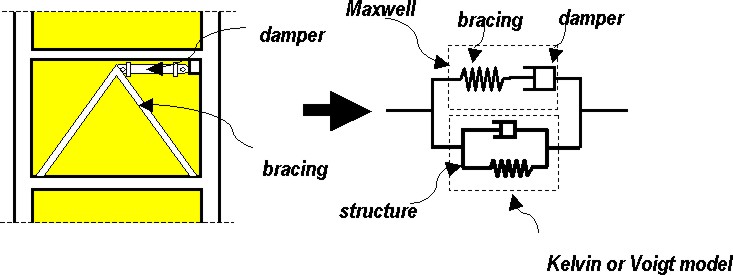
engineering & technology publications
ISSN 1759-3433
PROCEEDINGS OF THE TENTH INTERNATIONAL CONFERENCE ON CIVIL, STRUCTURAL AND ENVIRONMENTAL ENGINEERING COMPUTING
Supplemental Hydraulic Dampers for Buildings
+Department of Civil Engineering, Atma Jaya Yogyakarta University, Indonesia
*Faculty of Engineering, University of Wollongong, Australia
Although the theoretical analysis of the Maxwell model as time dependent elasticity has been well known [3], the use of this model in the dynamic analysis of structures involving inertial forces has not been further explored.
Numerical simulations were conducted using a 25-storey building similar to that in reference [4]. It was also reported that the damping ratio achieved in the first mode was 12.5%. In reference [2] the finite element method was proposed to analyse the building with supplemental dampers connected with inverted V-bracings. The proposed analytical model was also compared to the one when additional degrees of freedom were added at mass point between damper and floor mass, known as exact method in reference [2]. Numerical simulations of the 25-storey building confirmed that the method was in a good agreement with the exact method.
In this paper, the Maxwell model is analysed from the constitutive equation relationship. The rate of forces in the Maxwell model can be obtained accordingly. By defining the state vector as the displacements of the structure, velocities of the structure and forces in the Maxwell model, a state space equation can be obtained. The proposed method is then applied to a 30-storey building with supplemental dampers. Results compared with the numerical simulation show that the proposed method is in very good agreement with the exact method, where additional degrees of freedom are added in the damper location. However, if the exact method is converted to a first order differential equation as the state space equation, the sizes of the matrices in the proposed method in general are three-quarters of the one of the exact method.
- 1
- N. Kurata, T. Kobori, M. Takahashi, N. Niwa, and H. Midorikawa, "Actual Seismic Response Controlled Building with Semi-active damper System", Earthquake Engineering and Structural Dynamics, Vol. 28, pp. 1427-1447, 1999. doi:10.1002/(SICI)1096-9845(199911)28:11<1427::AID-EQE876>3.0.CO;2-#
- 2
- T. Hatada, T. Kobori, M. Ishida, and N. Niwa, "Dynamic Analysis of Structures with Maxwell Model", Earthquake Engineering and Structural Dynamics, Vol. 29, 159-176, 2000. doi:10.1002/(SICI)1096-9845(200002)29:2<159::AID-EQE895>3.0.CO;2-1
- 3
- W.N. Findley, J.S. Lai, and K. Onaran, "Creep and Relaxation of Nonlinear Viscoelastic Materials", North-Holland Publishing Co., Amsterdam, 1976.
- 4
- N. Niwa, T. Kobori, M. Takahashi, T. Hatada and K. Haruhiko, "Passive Seismic Response Controlled High-Rise Building with High Damping Device", Earthquake Engineering and Structural Dynamics, Vol. 24, pp. 655-671, 1995. doi:10.1002/eqe.4290240504
purchase the full-text of this paper (price £20)
go to the previous paper
go to the next paper
return to the table of contents
return to the book description
purchase this book (price £135 +P&P)
